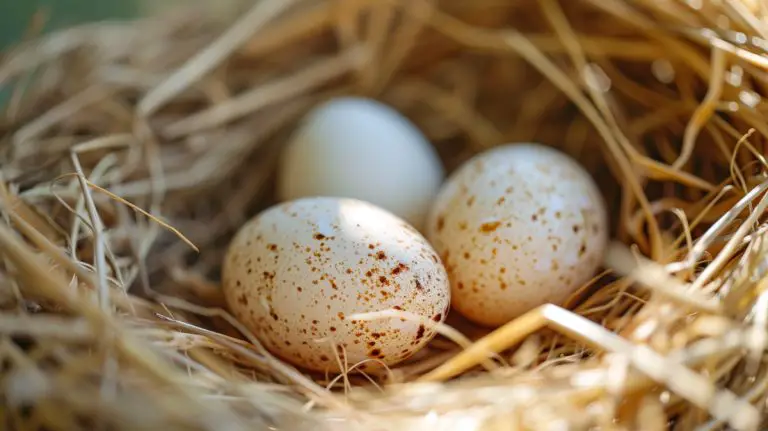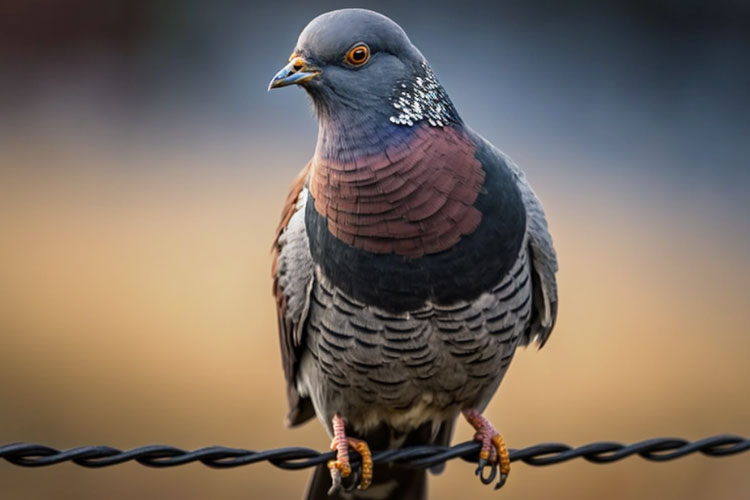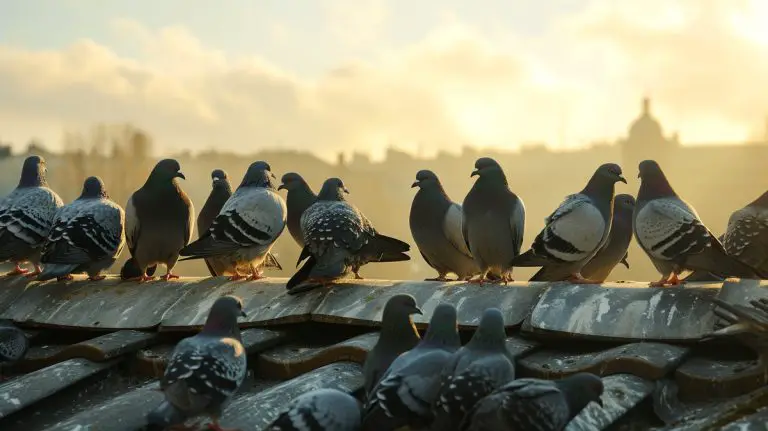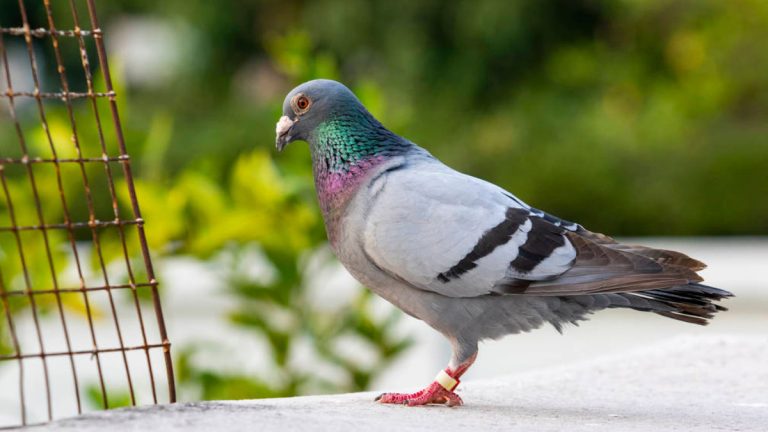From Courtship to Nesting: Understanding Pigeon Mating Behaviors
Pigeons are a type of bird that belongs to the Columbidae family, which also includes doves. They are widespread throughout the world and have been domesticated for many years for their meat, feathers, race, entertainment, and message-carrying abilities.
Comprehending the mating culture of pigeons can help us better understand bird behavior and their significance to the ecosystem.
So, how do pigeons mate? The male pigeon will enlarge his chest and coo to entice a female. The female pigeon will coo in return and bow her head if she is interested. After that, they will mate by pushing their cloacas together. In a few days, the female will lay and incubate the eggs.
We shall talk about the various stages of mating, pigeon courtship displays, pigeon breeding habits, and the reproductive process of pigeons in this article. So let’s start now!
Avian Reproduction: Discussing The Mating Process Of Pigeons
Pigeons are monogamous birds, which means they normally mate for life with just one partner. As a result, choosing a mate who would be suitable for them over the long term becomes very crucial for pigeons.
One of the first steps in pigeon mating rituals is finding a suitable mate. Pigeons use an array of gestures to entice potential partners, such as audible and visual signals. The table below lists a few of the signals used during bird courtship:
| Type of Signal | Description |
|---|---|
| Visual signal | Flapping their wings |
| Showing the size and color of feathers | |
| Strutting | |
| Stretching their neck feathers | |
| Dragging tail feathers | |
| Aural signals | Whistling |
| Clapping wings | |
| Groaning |
These audible and visual cues can reveal vital details regarding a mate’s genetic makeup, level of fitness, and reproductive success. And they help in mate selection.
A pigeon with healthy feathers, strong, clear call, and vibrant color, for instance, may be more alluring to potential mates. This is because these features denote good health and genetic quality.
Additionally, these gestures are a crucial component of bird mating behavior. Male pigeons regularly exhibit these behaviors to seduce females and signal that they are ready to breed.
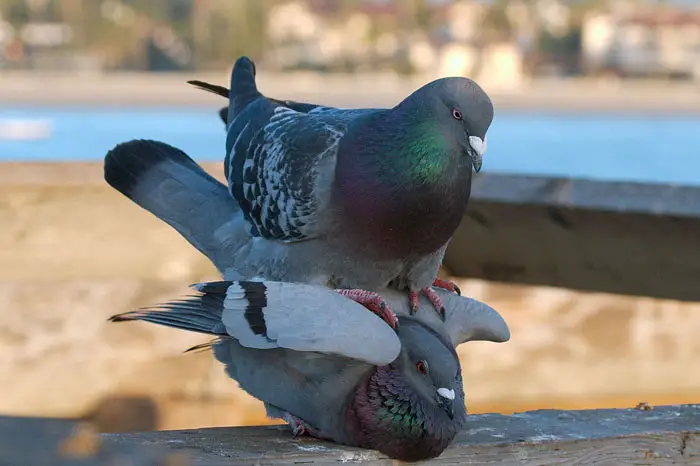
A male pigeon may engage in courting gestures that include bowing, chirping, and head bobbing once he gets a female’s attention. The male may also present the female with food or twigs as a gift. If the female is receptive, she might respond by preening herself, which is a sign that she wants to mate.
After successfully courting each other, a male and a female pigeon will mate. During mating, the male pigeon will normally mount the female from behind and make brief contact with the cloacas. This is the orifice where their reproductive organs are situated.
This procedure makes sure that sperm can be transported and that fertilization can take place, leading to the development of healthy eggs. Soon after mating, the female pigeon will deposit eggs. Female pigeons frequently lay a pair of eggs within a span of twenty-four hours.
The Frequency Of Copulation Of Pigeons
Copulation is a crucial part of the bird breeding process, allowing males and females to come together and produce offspring. Pigeons breed between March and July, though the precise time can change depending on the habitat and climate.
Pigeons ramp up their mating activity during this period, with males putting on courtship displays and females being more open to mating. The increased activity during the breeding season can have a significant impact on copulation frequency in pigeons.

Pigeon copulation frequency can vary significantly and is influenced by several variables, including-
- Age of the birds: Due to age-related changes in physical capacity and interest in mating, younger pigeons may mate more frequently than older pigeons.
- Environmental variables: Pigeon copulation frequency can also be influenced by the climate, access to food, living conditions, and other environmental factors.
- The bond between the pigeons: When a male and female pigeon develop a deep attachment, they tend to mate more frequently.
- Male dominance: Male pigeons who are dominant may have easier access to females and mate more regularly.
Understanding the Reproductive Anatomy of Male and Female Pigeons
Male pigeons play an essential role in fertilizing eggs. To understand this process, we need to delve into their reproductive anatomy.
Male pigeons have two testes responsible for producing sperm cells, which travel through tiny tubes called ducts. These sperm cells are stored in a saclike structure called the cloaca.

During mating, the male pigeon’s cloaca is everted, and the sperm cells are transferred to the female pigeon’s cloaca, resulting in fertilization. Moving on, female pigeons have two ovaries responsible for producing eggs.
Once the eggs are produced, they are released into the oviduct, where the male’s sperm cells fertilize them. The fertilized egg then travels down the oviduct, where it is coated with albumen and a hard shell before being laid.
What Are The Nesting Habits Of Pigeons?
Pigeons are well renowned for being extremely adaptable and are now widespread in urban and suburban regions all over the world. When it comes to nesting sites, pigeons typically like to construct their nests in protected areas that protect them from predators.
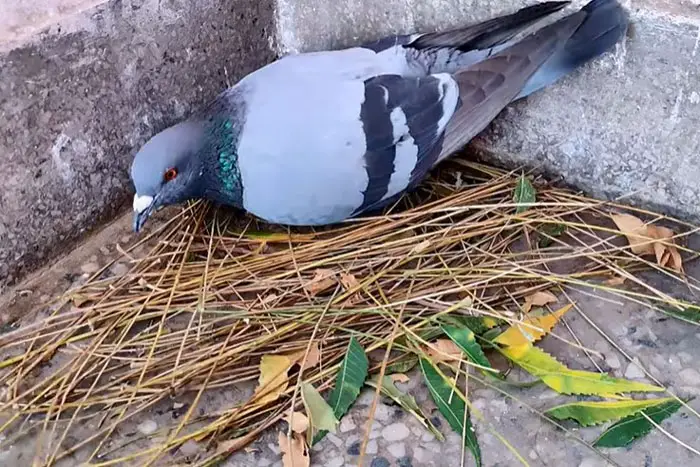
To build their nests, they typically choose stairways, warehouses, crevices, cracks in buildings, student hostels, bridges, and other structures. Pigeons generally make their nests out of the following materials:
- Twigs
- Sticks
- Leaves
- Grass
- Straw
- Feathers
- String
- Paper
Pigeons frequently build their nests in a range of sizes and shapes depending on the nesting materials they can find. The nest can be several inches to several feet in diameter and frequently have a spherical or bowl-like form.
The male and female birds work together to build the nest, with the male gathering materials and the female arranging them into a cup-shaped structure.
What Are The Roles Of Pigeons In Caring For Their Young?
Male and female pigeons play significant roles when it comes to caring for their young. These roles ensure the survival and growth of the young pigeons until they can fend for themselves. Pigeons fulfill the following roles in rearing their young:
- Building a nest- For their offspring, pigeons work together to build a nest. Once the nest is complete, the female will lay one or two eggs, which the parents will alternately incubate for about 16 to 19 days.
- Feeding their young– Pigeons produce crop milk, a nourishing fluid that is secreted from the crop glands in their digestive system.

They give their young crop milk during the first three days, which is rich in proteins, lipids, and antioxidants. The chicks are fed seeds, grains, and insects after around two to three weeks as they begin to grow.
- Protecting their chicks from harm– Pigeons are well known for their aggressive territorial behavior, and they frequently chase away other birds or animals that approach too closely to protect their nests and young.
Additionally, they display protective actions like aggressive posturing and making a loud noise to protect their young from predators.
- Keeping the chicks warm- At all times, one parent will stay with the chicks and snuggle up to keep them warm and safe.
What Dangers And Challenges Do Pigeons Encounter In Urban Areas?
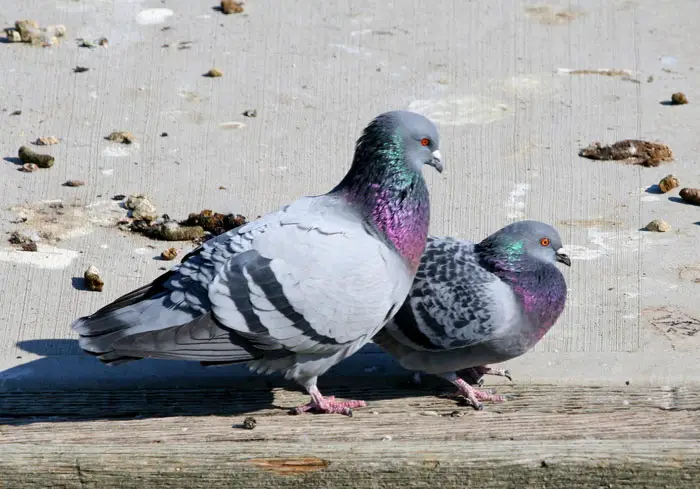
Many pigeon species are subject to a variety of challenges and dangers to their existence. The following are some of the most typical threats they may encounter due to urbanization:
Environmental pollution
In urban areas, pigeons are subject to different forms of pollution, such as water and air pollution. Exposure to high levels of pollution can cause respiratory problems, decreased immune function, and harm a pigeon’s ability to reproduce.
According to a study, urban environments expose pigeons to significant levels of heavy metals, which can cause oxidative stress and other health issues.
Global warming and climate change
Pigeon populations all across the world may be significantly affected by climate change. Food supply, migration patterns, and breeding success can be impacted by changes in temperature, humidity, and weather patterns.
The distress caused by humans
Human activities like construction, hunting of birds, and noise pollution frequently bothers pigeons. This may interfere with how they nest and eat, decreasing the likelihood of successful reproduction.
Lack of habitat
Biodiversity is seriously threatened by urban environments. As cities expand, natural pigeon habitats are being lost, which can reduce their access to food and nesting sites.
According to a study, the diversity and quantity of birds were found to be higher in regions with more green space and natural habitats than in areas with more buildings and towers.
How do conservation initiatives help to maintain pigeon populations?
The well-being of pigeons is directly related to the quality of their habitat, and protecting their habitats is a crucial part of conservation efforts.
This involves safeguarding pigeon breeding sites, ensuring that they have access to enough food and water, and managing environmental threats such as pollution, habitat loss, and invasive species.
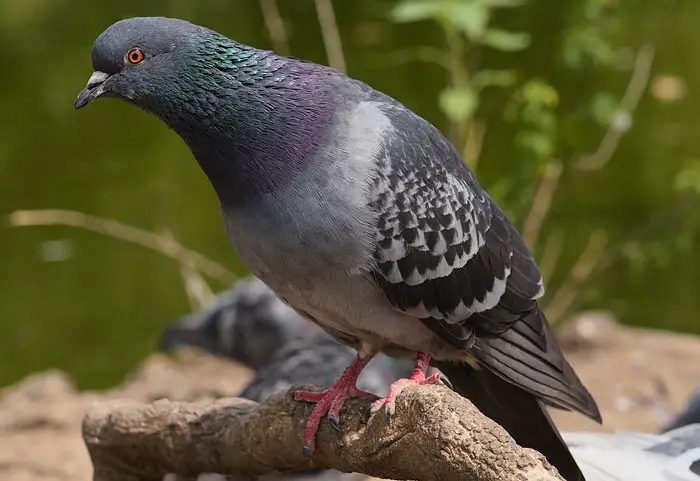
But that’s not all. Research also plays a vital role in conservation initiatives. Avian conservation organizations, like the International Union for Conservation of Nature, are dedicated to protecting and conserving pigeon populations.
By conducting extensive research, these organizations and research institutions can identify the factors that are endangering pigeon populations and create effective mitigation plans. By taking a comprehensive approach to conservation, we can help ensure that pigeon populations thrive for generations to come.
Whether it’s through protecting their habitats, creating awareness or conducting research to identify potential threats, we all have a role to play in preserving these incredible birds.
If you’re interested in learning more about the fascinating history of pigeons in human cities and pigeon-proofing buildings, you may find our articles on the fascinating history of pigeons in human cities and pigeon-proofing buildings informative. Our article on the fascinating history of pigeons in human cities delves into the long and intricate relationship between pigeons and humans throughout history, highlighting their roles in various cultural, architectural, and communication contexts. Meanwhile, our article on pigeon-proofing buildings explores effective strategies and techniques to prevent pigeons from roosting or nesting on buildings, offering practical solutions to minimize potential damages and conflicts. These articles provide valuable insights into the historical significance of pigeons in human cities and effective methods to mitigate pigeon-related issues in building environments.Final Words
In conclusion, as social creatures, pigeons have a lot to teach us about the importance of bird communication, social bonding, and courtship displays.
Pigeons are intriguing birds with unique mating habits. So, understanding pigeon behavior and their courtship displays is crucial if you’re interested in breeding them.
You can gain a better understanding of these birds and their significance to the ecosystem by paying attention to their mating behavior. You can also develop a successful breeding program, prevent any breeding issues, and protect the health and welfare of your flock by studying pigeon behavior.



